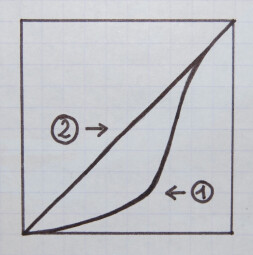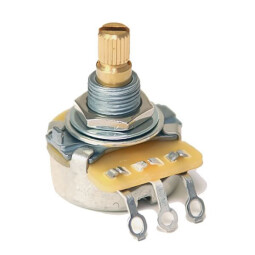Most guitarists don't think too much about the pots (potentiometers) inside their guitars, unless they start going bad and making noise. But did you know there are different types of pots with different characteristics? So if you need to replace a pot because it's become noisy, or you just don't like the way it responds, here's some info to help you choose the type that's best for you.
I will limit myself here to passive electronics, which requires the following note: Regardless of the potentiometers you choose, they won’t add any level to your signal. In other words, the nominal position of a pot is when it’s cranked all the way up — turning it can only lower the signal.
Of LOGs and LINs
|
Curve 1 represents the slope of a logarithmic pot and curve 2 that of a linear one, with the action on the pot on the horizontal axis and the quantity of the signal delivered on the vertical axis.
|
I’m not going to try to teach you anything about physics, but it won’t hurt to talk a bit about mathematical curves.
The logarithm is used to describe the slope of a potentiometer to try to reproduce the curve of our precious ears. The linear curve, which is more recent, proposes a straight and proportional slope.
Thus, a linear pot delivers half the signal when set to 5, while a logarithmic one lets through much less signal (each brand has its own curve). But when cranked all the way up, there’s no difference between both of them, since it’s only the slope that changes. As such, log and lin pots won’t be of much interest to guitarists who use their volume pot as an on/off switch. But the rest ought to test both possibilities depending on their needs (violining, gain management…).
And kΩ
The other main characteristic of a potentiometer has to do with the resistance of the pots, expressed in Ohms. Simply put, you will have to choose 250 kΩ for a single-coil or 500 kΩ for a humbucker to avoid any problems, be it for the volume or tone. If your guitar is equipped with both types of pickups and only one volume pot, go for 500 kΩ. But take this just as an advice and you can always try any other combination you feel like without the risk of damaging anything.
Wise changes
Tone pots are optional and people who like to get the most natural sound will not hesitate to just take them out. Nevertheless, these little knobs may prove useful, and even indispensable, to get muffled clean sounds or damped distortions. People who want to have their cake and eat it should try “no load” pots, which are similar to a pedal’s “true bypass.” These type of pots function just like a standard model from 0 to 9 and have a detent at 10, where they are shorted to let the signal go through in its entirety. They’re a good choice for demanding guitarists or for those who have signal problems, despite the presence of a buffer on their pedalboards.




